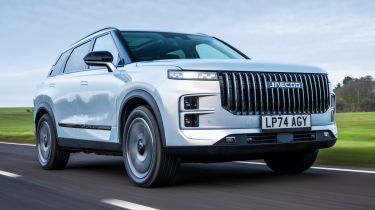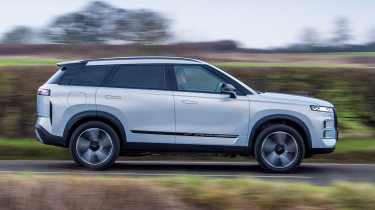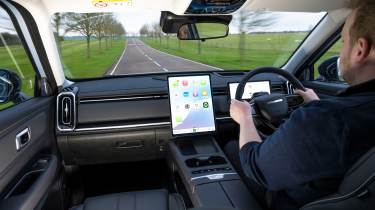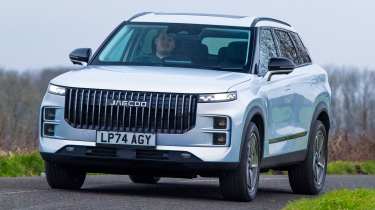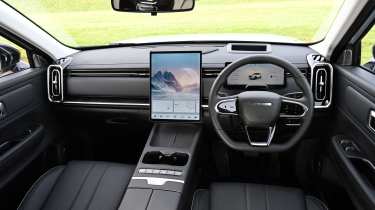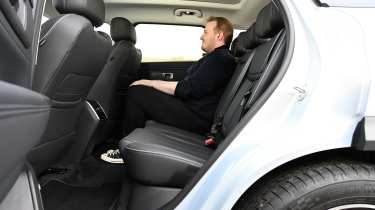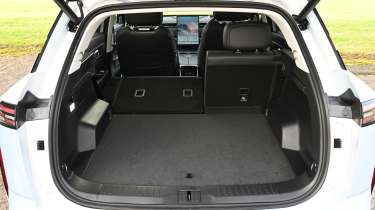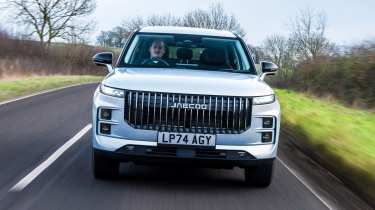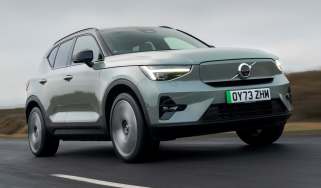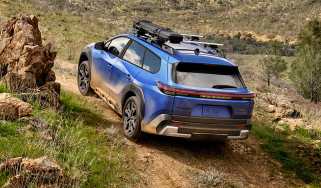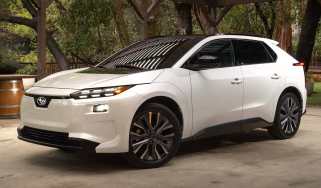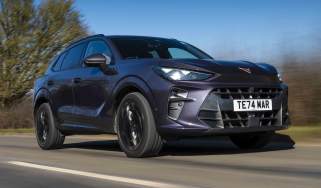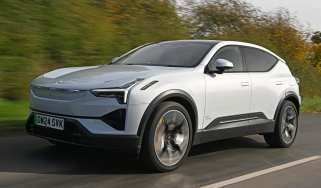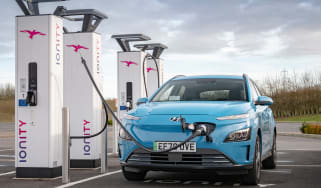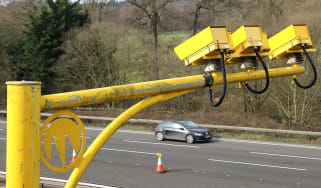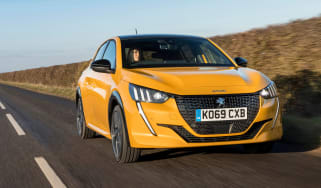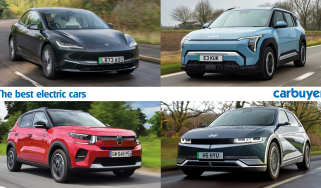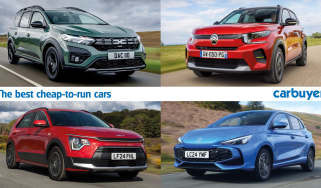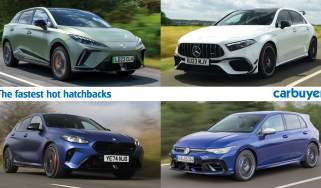Jaecoo 7 review – more car for Qashqai money
“The Jaecoo 7 has presence, lots of kit and is frugal in hybrid form, but the driving experience isn’t the best on offer”
Pros
- Lots of standard equipment
- Frugal plug-in hybrid system
- Upmarket looks
Cons
- Unsettled ride in plug-in hybrid version
- Sluggish power delivery
- Intrusive driver attention monitoring
Verdict – is the Jaecoo 7 a good car?
Jaecoo has hit the ground running with the 7 SUV. It looks good, and that will be enough to persuade many buyers, but compare it to a real Range Rover (which you shouldn’t) and it won’t come close. It’s very well equipped, though, which could win over those with the cash for a Qashqai – just don’t expect too much from the driving experience or ride quality. At least it's safe too, as backed up by a five-star Euro NCAP rating.
Jaecoo 7 models, specs and alternatives
The market is suddenly being flooded with cars from Chinese brands you might not have heard of before, and Jaecoo is one of the latest to hit the UK, launching with the Jaecoo 7 SUV. While it may not quite roll off the tongue, ‘Jaecoo’ is a portmanteau of the German word ‘Jaeger’ (meaning ‘hunter’) and ‘cool’, and it’s actually a brand that solely exists in export markets outside of China.
Jaecoo sits alongside a sister company you may or may not have heard of, called Omoda, while both of these brands are under the Chery umbrella, one of China’s largest automakers. Jaecoo positions itself as the more conservatively-styled, upmarket brand of the two, while Omoda features more outlandish designs for fashion-conscious buyers, we’re told.
While the Jaecoo 7 may be new to us, it’s actually been around for some time being sold under parent company Chery as the Chery Tantsuo 06. As with many less well-known brands hoping to make a name for itself in the UK, the Jaecoo 7’s focus is on value for money, so it costs from just over £29,000 and gets lots of kit as standard, though going for the top-spec plug-in hybrid model will set you back just over £35,000.
Jaecoo has given the 7 a rather familiar design – some of the styling is reminiscent of a cut-price Range Rover, especially with the tapered clean-cut silhouette from the side and full-width rear lightbar. The front features a particularly large grille – a staple of upmarket cars in China – and thin horizontal headlights framing its sides.
There are two trim levels from launch, called Deluxe and Luxury. Though there may be hints of Range Rover on the outside, as you’d expect from the price, it’s not quite Range Rover levels of luxury on the inside. Still, the Jaecoo 7 offers buyers a compelling kit list on a car that seems more upmarket than, say, a Nissan Qashqai on the surface. It's safe too, bagging an impressive five-star Euro NCAP score in spring 2025, with scores of 80% or more in every category.
| Trim levels | Power options |
|
|
MPG, running costs & CO2 emissions
From launch there are three variations of Jaecoo 7 on the UK market, each with varying degrees of fuel efficiency. The 1.6-litre engine can be specified with front or all-wheel drive, but be aware that going for the latter will dent your fuel economy somewhat. During our testing of a front-wheel drive Jaecoo 7 we averaged 27.4mpg, which was quite a way down on the Skoda Kamiq 1.5 TSI we managed 43.8mpg in with similar driving.
Jaecoo is making lots of noise about the Super Hybrid System (SHS) on the flagship version of the 7. This is a plug-in hybrid system the brand says also regularly self charges, so you don’t always need to plug it in as you might with other PHEVs. It uses a 1.5-litre petrol engine combined with an 18kWh battery that gives it an electric range of up to 56 miles. Unlike other plug-in hybrids, the Jaecoo 7 is programmed to never let the battery fall to 0% – that will be particularly handy if you don’t have a home wallbox charger. When using the Jaecoo 7 in hybrid mode, the brand claims a range of up to 745 miles to a tank of petrol. We’d take all of these mpg stats with a pinch of salt, however, as it will really depend on how and where you drive and how often you charge.
| Model | Fuel economy | CO2 emissions |
| Jaecoo 7 front-wheel drive 1.6-litre petrol | 37mpg | 169g/km |
| Jaecoo 7 all-wheel drive 1.6-litre petrol | 35mpg | 182g/km |
| Jaecoo 7 SHS | 403mpg | 23g/km |
How much will the Jaecoo 7 cost in tax?
At present, the petrol Jaecoo 7 will cost the standard rate of VED (road tax), while the plug-in hybrid will benefit from a £10 discount on that rate thanks to its status as an ‘alternative fuel’ vehicle. From April 2025, however, all cars will cost the standard rate.
What will the Jaecoo 7 cost to insure?
The Jaecoo 7 is yet to get official insurance group ratings, but it will have to compete with the Nissan Qashqai which sits between groups 11 and 26 out of 50.
Engines, drive & performance
Jaecoo is keen to point out that the 7 benefits from a high ride height, can wade through deep water and can be specified with all-wheel drive, backing up its chunky 4x4 looks. In reality, we suspect most buyers are likely to be in the market for an SUV simply to benefit from a more commanding view of the road, more forgiving jacked-up ride for UK pothole-filled roads, and perhaps the occasional drive over a grassy field.
On one of those points the Jaecoo 7 does impress – the squared-off bonnet and high driving position will give drivers a sense of confidence from behind the wheel and makes it feel like you’re driving something much larger, like a Range Rover.
Sadly, the Jaecoo 7 isn’t quite as refined as premium SUVs from traditional manufacturers, and there was a lot of wind and road noise when we drove it on the motorway, most likely because of the large door mirrors which don’t seem the most aerodynamic.
To be blunt, the Jaecoo 7’s ride was disappointing in the SHS plug-in hybrid version. It wasn’t particularly harsh, but we found the 7 never really settled over imperfections during our time with it, even when cruising at steady speed on the motorway. We actually found the ride quality to be better in the pure-petrol Jaecoo 7, which we suspect is down to it weighing less.
Driving the Jaecoo 7 around twisty country roads, we found the steering to be vague, and it will understeer if you push too hard. In town, though, you’ll be thankful for the light weight of the steering because it makes urban driving a breeze. When we put the Jaecoo 7 head-to-head with a Skoda Kamiq, we found the Czech car was more composed around corners, yet still managed to ride more smoothly as well.
We found the SHS plug-in hybrid’s regenerative braking system underwhelming to use, because it didn’t provide much stopping power, so don’t expect anything close to the feeling of one-pedal driving like you might in some EVs or even other plug-in hybrids like the Volvo XC60.
One of the Jaecoo 7’s most annoying attributes is the sheer amount of driver assistance systems which bong and ping at you on the move; something that tends to be a bugbear in cars released from other Chinese brands, too. Look at the touchscreen for a second and you get a warning telling you to pay attention – we even looked at the warning message itself on the driver’s display and it bonged at us again. Hopefully these systems could be recalibrated as part of a software update, because they really can get distracting.
Petrol models
The petrol version of the Jaecoo 7 uses a 1.6-litre engine to deliver power to either the front wheels or all four, depending on whether you go for the all-wheel drive model or not. It’s not the most refined unit, and can be rather coarse when you put your foot down – there’s also quite a long delay between the moment you do and the speed begins to pick up, which can be frustrating, especially if you want to overtake. Despite having just 3bhp extra, we found the smaller Skoda Kamiq offered noticeably stronger performance.
| Model | Power | 0-62mph | Top speed |
| Jaecoo 7 1.6-litre petrol front-wheel drive | 145bhp | 10.3seconds | 112mph |
| Jaecoo 7 1.6-litre petrol all-wheel drive | 145bhp | 11.8 seconds | 112mph |
Plug-in hybrid models
The Jaecoo 7 is available as a plug-in hybrid, which the brand markets as the ‘Super Hybrid System’ or SHS. This differs from most PHEV setups in that the battery is never allowed to fall completely to 0%, so it acts much like a self-charging hybrid in many scenarios. When it runs low, the 1.5-litre petrol engine wakes up to charge it up. The engine can be set to work alone, or the electric motor can be used to power the car for up to 56 miles, assuming it has enough juice.
We were impressed with how refined the Jaecoo 7 SHS was – most of the time it was so quiet and smooth that it felt almost as if we were driving an electric car, and even when the petrol engine did chime in it was much quieter than we’d expected.
| Model | Power | 0-62mph | Top speed |
| Jaecoo 7 SHS 1.5-litre petrol plug-in hybrid | 201bhp | 8.5 seconds | 108mph |
Interior & comfort
Step into the Jaecoo 7 and it’s quite clear it’s been inspired by some of Land Rover’s latest models. The interior door grab handles are designed to look like they’re held on with exposed rivets much like those of the Land Rover Defender, and things are otherwise fairly minimalist.
Some of the design choices are a little tacky, such as the large overdesigned gear selector on petrol models (the plug-in hybrid’s drive selector is column-mounted). Overall, though, the Jaecoo 7’s interior is inoffensive and we’re glad to see soft-touch materials on the dash and major touch-points, though look lower down and you will find scratchier black plastic. Fit and finish is mostly good, although on the move we did hear the occasional creak from some of the plastics.
Some features are novel – there’s even a mode for the ambient lighting that sees it pulse and change colour in response to the music. It might be fun when parked up, but we doubt you’d want to select it whilst driving along a dark stretch of motorway.
Is the Jaecoo 7’s infotainment and sat-nav system easy to use?
The Jaecoo 7 gets a large central portrait infotainment screen which is 13.2 inches in size on Deluxe models and 14.8 inches big on Luxury spec cars. Ahead of the driver there’s also a 10.25-inch digital display.
Both the infotainment screen and driver’s display are crisp and responsive, though we wish the text on the driver’s display was a bit larger as it can be hard to read at a glance. The infotainment software is laid out like a smartphone, so most buyers shouldn’t find it too hard to find what they’re looking for, but we weren’t a fan of how many submenus some features seemed to have, which would make it hard to navigate on the move.
Thankfully, Jaecoo has included wireless Android Auto and Apple CarPlay connectivity, so if you’re used to using that you’re also catered for. Annoyingly, though, some of the shortcut buttons and climate controls get cut off when you use these interfaces, only to reappear if you swipe the screen, which isn’t ideal if you’re on the move.
Key features | |
|
Deluxe
|
Luxury (Deluxe plus…)
|
Boot space, practicality & dimensions
The Jaecoo 7 is unashamedly boxy, but that means it boasts lots of interior space for passengers. There’s loads of headroom and legroom in the rear. Jaecoo has designed the 7 with the rear passengers in mind, because some models even get a button on the back of the front passenger seats so that rear-seat passengers can adjust it and move it forward if they need extra space, although we imagine you won’t want to tell your kids that.
There are two sets of ISOFIX points in the rear for attaching child seats, but disappointingly there’s just one air vent for rear passengers, one USB charging point and one USB-C charger. Happily, at least, every Jaecoo 7 gets wireless smartphone charging pads in the front and there’s lots of storage space in the centre console
| Size comparison | |||
| Model | Length | Width | Height |
| Jaecoo 7 | 4,500mm | 1,865mm | 1,680mm |
| Nissan Qashqai | 4,425mm | 1,835mm | 1,625mm |
| Hyundai Tucson | 4,510mm | 1,865mm | 1,650mm |
| BMW X1 | 4,500mm | 1,845mm | 1,642mm |
Does the Jaecoo 7 have a big boot?
The Jaecoo 7’s 412-litre boot capacity increases to 1,335 litres if you fold down the rear seats. There’s even a space underneath the boot floor to store the charging cables in the plug-in hybrid model. These aren’t particularly class-leading boot-space figures – a MINI Countryman offers 450 litres, the BMW X1 boasts 540 litres and the Hyundai Tucson, despite being just as long as the Jaecoo 7, can fit up to 620 litres. However, the Jaecoo 7 is cheaper than a Skoda Kamiq and has around 100 litres more boot space.
| Boot space comparison | |
| Model | Boot space |
| Jaecoo 7 | 412 litres |
| Nissan Qashqai | 455-504 litres |
| Hyundai Tucson | 558-620 litres |
| BMW X1 | 476-540 litres |
Reliability & safety
Going for a car from a brand that’s unknown in the UK could feel daunting as there’s no reliability data to go off. That said, Jaecoo does offer a competitive warranty for the Jaecoo 7, so it’s covered for up to seven years or 100,000 miles, whichever comes first – that could go some way to alleviating some of those worries.
How safe is the Jaecoo 7?
Jaecoo promised us that Euro NCAP would be awarding the 7 a full five-star rating, and now the results have been published it does indeed hit all the marks. A five-star overall score matches the closely-related Omoda 5, while the Jaecoo 7 managed 80% in every category except adult occupant protection, where it hit 81%.
As standard, the Jaecoo 7 comes with lots of safety kit including a 540-degree camera, front and rear parking sensors, safe exit warning, lane departure warning, autonomous emergency braking and rear cross-traffic alert.
Should you buy a Jaecoo 7?
The Jaecoo 7 is definitely worth your consideration if you have Nissan Qashai money to spend, but want to see it go further. A big reason buyers might go for the Jaecoo 7 is its Range-Rover-like styling and upmarket feel, but it’s also very well equipped for the money and you get the benefits of a plug-in hybrid system for low running costs, or a simple 1.6-litre petrol engine if you’d rather keep the starting price as low as possible.
It’s certainly not perfect though – a luxury SUV it is not, and the driving experience does leave something to be desired. The Jaecoo 7’s European and Japanese counterparts feel better to drive and are more comfortable, but you will have to pay lots more if you want a comparable specification.
What is the best Jaecoo 7 for low running costs?
While it may cost the most of the lineup, the Jaecoo 7 SHS plug-in hybrid is your best choice if you want lower running costs thanks to its ability to drive for 56 miles on electricity alone and the impressive fuel economy this brings.
Jaecoo 7 alternatives
The Jaecoo 7’s biggest rival is the Nissan Qashqai, which leads the family SUV segment. Jaecoo aims to give more premium models a run for the money, too, though, by offering more equipment as standard, a plug-in hybrid powertrain and an upmarket look.
How we tested the Jaecoo 7
We tested a prototype Jaecoo 7 in May 2024, and then both the front-wheel drive petrol Jaecoo 7 and Jaecoo 7 SHS plug-in hybrid on UK roads in January 2025 in cold, dry weather. A few months later we also put the Jaeco 7 up against the Skoda Kamiq on British roads.
Visit our sister site Auto Express for an alternative view on the Jaecoo 7...
Which Is Best?
Cheapest
- Name1.6T Deluxe 5dr 7DCT
- Gearbox typeAuto
- RRP£29,435
Most Economical
- Name1.6T Deluxe 5dr 7DCT
- Gearbox typeAuto
- RRP£29,435
Fastest
- Name1.5T SHS Luxury 5dr Auto
- Gearbox typeAuto
- RRP£35,055
